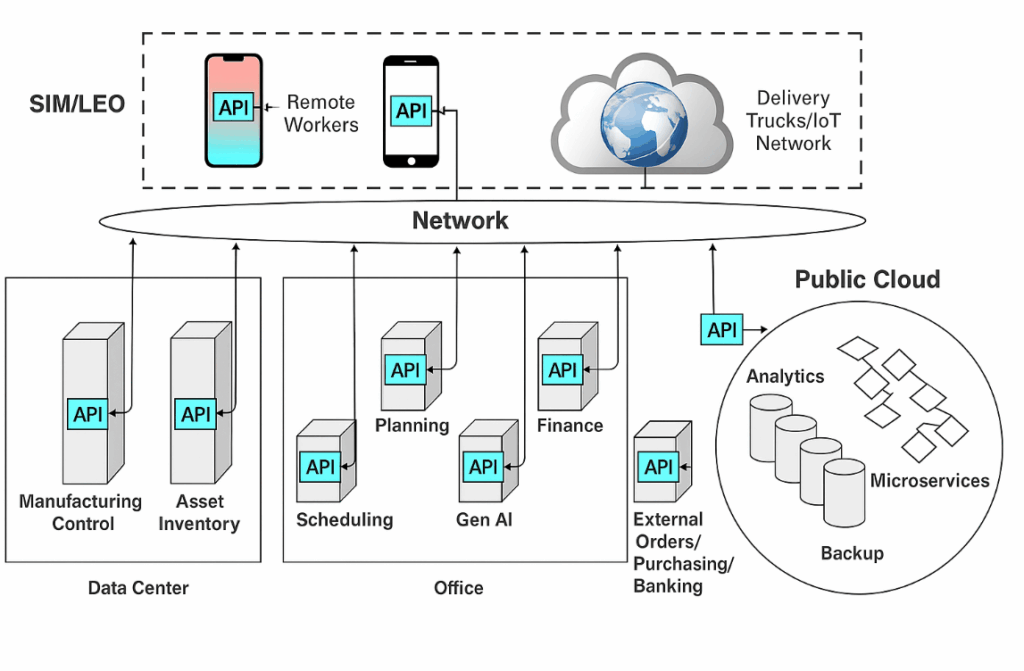An Intellyx BrainBlog for Globalgig
Introduction
Years ago, when I was working at Digital Equipment Corp (now part of HP), I was sitting at a lunch table with some hardware engineers.
Since I was working as a software engineer, when they started talking about “interfaces” I immediately imagined a system library call or a remote procedure call.
No, they were talking about where you plugged something into the computer, such as a network interface.
It was then that I realized why we had so much trouble getting attention from the execs and the sales reps. Software was just an afterthought, a given – the chrome on the bumper of the car.
But in reality, when you are planning a network and checking to see whether that network is working well, you really have to think about how the software systems are connected, what data they are sharing, and how they are sharing it – it’s not just about the hardware interfaces, network routers, and network underlay.
Example Network Topology

This diagram represents a typical mixture of connected applications and devices in an organization’s network.
Focusing on the types of connectivity most organizations require for their day-to-day operations, it illustrates what’s important in designing, managing, and maintaining the supporting network.
The diagram represents multiple networking challenges, including connecting an organization’s internal network to external networks, such as the public cloud and external partners. New to many organizations is the need to include 5G and LEO for mobile and IoT devices.
Using a managed SIM solution to connect mobile devices and IoT devices may represent a new challenge for an organization not used to considering these types of devices part of a corporate network.
Yet business requirements are continually pushing the network edge into scope. 5G networks perform well enough to serve as a backup for a primary network, should there be a failure or outage. This increases resiliency but also adds complexity to network management.
In Modern Organizations Data is the Constant
In today’s connected world, it’s a common requirement for organizations to deploy and manage a hybrid network environment, including direct internet access (DIA), WiFi, 5G, and LEO.
Many organizations include connected devices, such as delivery trucks, employee access gateways, security cameras, and shop floor controllers, to name a few. And workers increasingly conduct business using their mobile devices, sometimes from remote areas.
In particular for mobile devices and IoT devices, the emphasis tends to be on the device rather than on the data it’s sending back and forth. Is the device working properly? How about, is the network configured properly?
But mostly, the question is what kind of data is being transmitted? How much? And how often?
Are the devices sending photographs back to corporate systems? Are corporate systems sending documents, spreadsheets, and diagrams to mobile devices? What kind of video calling are they using to communicate with people in the office, customers, and each other?
Are the IoT devices streaming video to a security console or streaming real time telemetry from vehicle control systems to track location and vehicle status?
And are the devices secure? Can you prevent breaches and outages, and detect and respond to incidents quickly enough to preserve communications?
Mobile Device Connectivity
Of course for IoT and mobile devices a big consideration is the wireless telecom network’s capacity and bandwidth. The network overall needs to have sufficient capacity for not only the number of devices connected, but also for what those devices are doing.
Designing, operating, and maintaining a complex network to support such an organization involves multiple elements, and multiple types of networks: wired, SDN, connect to cloud, 5G and LEO.
This is why it makes sense to also think about the APIs – the application program interfaces instead of looking just at the network characteristics. You will never really get such a complex network right unless you take into account what the applications on it are doing.
Looking at the APIs you can see what data is being exchanged, and how (sync, async, in small messages, file transfers, streaming, etc.).
The network has to be able to handle the load, be resilient to failure, and scale dynamically up and down for elastic workloads across the cloud, data center, and hybrid deployments.
Add gen AI to the mix and you have to account for additional network resources to move the data for the prompts and responses back and forth reliably and quickly.
How Globalgig Can Help
Globalgig started out supporting mobile SIM roaming networks, and now offers an integrated networking platform for provisioning and managing WiFi, SD-WAN, LEO, and cloud connectivity across any networking hardware.
Their Orchestra Platform is a SaaS-based managed communication platform, supporting wireless, SD-WAN, network services, voice, managed services, and AI assistance.
They provide a comprehensive, AI-powered dashboard to monitor and adjust your complex, multi-protocol network for the best performance and resilience so that you can be sure not only to support data, voice, and video sharing and transmission requirements, but also ensure the highest level of uptime and availability.
One of the Globalgig user services platforms (USPs) within Orchestra is eSIM. The eSIM interface an organization’s 5 G data, pooling data from not just one but multiple carriers, controlling that data across multiple devices and applications.
When a wireless SIM at a remote office needs three times the data than a wireless SIM in a specialist factory, for example, eSIM quickly makes the adjustment without pausing to send a tech out to change the SIM. Orchestra just makes the change in the eSIM interface, and it pushes the information to the SIM in the facility, immediately changing the profile to leverage more data.
The Intellyx Take
Modern network requirements continue to grow and expand, and organizations connect more and more devices to their networks and try to make sense of it all.
The best way to ensure your network is doing what you need is to ensure it meets the requirements for moving data among devices and from internal to external networks.
Globalgig’s platform not only provisions and monitors multi-protocol networks, including 5G and LEO, but it also helps you figure out where and how to improve network settings and capacity to handle your organization’s overall network load.
This is like a telecom company network management system in a box you can configure into your network, and operate yourself the way a telecom company might do it for you otherwise. But using Globalgig not only helps you have greater control and reliability, but it also is more cost efficient.
Copyright © Intellyx B.V. Intellyx is editorially responsible for this document. No AI bots were used to write this content. At the time of writing, Globalgig is an Intellyx client. Image by SpaceX from Pexels.com.

Guest Author
Eric Newcomer, Principal Analyst & CTO, Intellyx
Eric Newcomer is Principal Analyst and CTO at Intellyx, a technology analysis firm focused on enterprise digital transformation.
Eric was CTO of WSO2 most recently, was also CTO of IONA Technologies, and is an internationally recognized expert in transaction processing, web services, SOA, and cloud migration. His books have been translated into multiple languages and are used as textbooks in universities across the globe. He shares a patent on mobile middleware technology.
Eric also was Global Head of Security Architecture at Citi’s Consumer Bank, Chief Architect at Citi’s Treasury and Trade Services Division, and Chief Architect at Credit Suisse’s Investment Banking Division.
Eric started his career in technology at Digital Equipment Corporation (now part of HP), where he was a Distinguished Engineer and Transaction Processing Architect.
Eric has contributed to many industry standards, including OSGi, Eclipse, SOAP, WSDL, UDDI, WS-Security, OTS, AMQP, STDL, and XA. He is co-author of the OASIS WS-Transactions spec and chaired the Java based OSGi Enterprise Expert Group. Eric also served as a Director on the OSGi and Eclipse Boards of Directors, and oversaw IONA’s open source projects. Most recently he led WSO2’s transition from data center software to cloud software as a service.
Eric is the author or co-author of three widely respected textbooks: Principles of Transaction Processing (with Phil Bernstein), Understanding Web Services, and Understanding SOA with Web Services (with Greg Lomow).
©2025 Intellyx B.V. Intellyx is editorially responsible for this document. At the time of writing, Globalgig is an Intellyx subscriber. None of the other organizations mentioned here are Intellyx customers. No AI bots were used to write this content.
